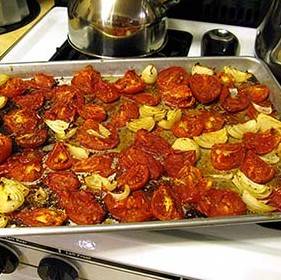 In the U.S. pasta sauce has traditionally been a labor of love, something that your parents, grandparents, or even you in an intrepid mood, made possibly over the course of an entire day or days. The process took up most of the kitchen and involved tending a giant pot or pots for hours, and typically raised the humidity level in your house or apartment by a good 10 to 15 percent — just what you need in the middle of summer in the Midwest.
In the U.S. pasta sauce has traditionally been a labor of love, something that your parents, grandparents, or even you in an intrepid mood, made possibly over the course of an entire day or days. The process took up most of the kitchen and involved tending a giant pot or pots for hours, and typically raised the humidity level in your house or apartment by a good 10 to 15 percent — just what you need in the middle of summer in the Midwest.
By switching the process from the top of the stove to inside the oven, you can make a perfectly good pasta sauce with no pot watching and no stirring and without your body adhering to your furniture. Just throw the tomatoes, onions, and garlic on big baking sheets; drizzle with olive oil; toss with salt and pepper; and walk away.
Will it be the same as grandma’s? Depending upon your grandma, it may be better. Prolonged cooking times, which are not typical of Italy by the way, can concentrate compounds in tomatoes that can make the resulting sauce bitter. Additionally, removing the seeds from the sauce by running it through a food mill removes a substantial amount of the vitamins as the majority are located in the gel sacks surrounding the seeds.
I first saw this technique in Cook’s Illustrated, but New York Times columnist Mark Bittman also is credited with an oven sauce recipe, albeit, one that uses canned tomatoes. Food bloggers and celebrity chefs also have produced versions over the last few years. The problem with many of these recipes is that they add unnecessary steps and complexity to what should be a simple process. For example, some advise starting with one temperature and changing it midway through. Apparently these people have “special” ovens that are somehow the same temperature at the bottom and center. The reality is that unless you have a convection oven, any tray placed in the bottom third of your oven will cook faster than one in the center. If you use a constant temperature, you can pull out the bottom tray and put in a new one without worry, because let’s face it, if you have enough tomatoes to make sauce, it’s going to take more than two trays.
However, the most glaring oversight in many of these recipes, including Alton Brown’s, is that they leave the key flavor components from the process behind. As the tomatoes cook on the baking sheet, their sugars react with their primary amino acids: aspartic acid and glutamate. This is called the Maillard Reaction and is why a sandwich that is on toasted bread tastes better than one on untoasted bread. By adding just a few tablespoons of water or wine to the tray at the end of the cooking time you can steam loose the browned sugar-amino acid compounds. This will take your sauce from ho-hum to spectacular.
After this step, just scrape everything from the trays into a food processor or blender. Puree it and freeze it in zipper bags. Because you are freezing the sauce, you can add as few or as many onions or garlic cloves to the recipe as you like along with any basil, oregano, or flat leaf parsley when you puree it. When you are ready to use the sauce, just thaw a bag. Heat through and thin with a bit of wine or water to the consistency you prefer. It really is that easy. And, if you buy tomato seconds at the farmers market it doesn’t have to be that expensive to have great sauce.
Oven Roasted Pasta Sauce
- 5 pounds fresh tomatoes (Romas or slicing)
- 3 small to medium onions, peeled and cut into wedges
- 6 cloves garlic, peeled
- Olive oil to drizzle
- Salt and Pepper to taste
- a few tablespoons of water or wine
- fresh basil, oregano, or flat leaf parsley, if desired
Preheat oven 350 degrees F. Halve Romas if using. If you are using slicing tomatoes, core them, and gently squeeze out a bit of the excess juice. Cut them into Roma-sized pieces. Place tomatoes and a handful of onion and a few garlic cloves on a baking sheet in a single layer. Drizzle with olive oil. Toss to lightly coat, returning them to a single layer. Sprinkle with salt and pepper. Roast for 1 1/2 to 2 hours until they look like the picture above. Add a few tablespoons of water or wine to the tray to release the browning residue. Using a silicone or rubber spatula, scrape everything on the tray into a food processor or blender. Puree to desired consistency, adding fresh basil or oregano if desired. Use immediately, or allow the sauce to cool and transfer to zipper freezer bags. Freeze flat.
To use frozen sauce, thaw and heat through. Thin with a bit of wine or water to desired consistency.
Variations: You can also add sauteed Italian sausage and crushed fennel seed after pureeing, and/or a pinch of red pepper flakes.








